Instructions for planting viburnum in the fall for beginner gardeners
Viburnum (Viburnum) is a common and beloved representative of the Adoxaceae family in Russia. The shrub is valued for its decorative appearance and bitter fruits, which have healing properties.
According to experienced gardeners, the best time to plant viburnum is autumn. We will explain below what its advantages and features are.
Features of planting viburnum in autumn
Most varieties and varieties of viburnum have good winter hardiness and frost resistance, so they can be planted in the fall.
Young seedlings will easily survive the first winter and produce viable shoots with the onset of warm weather next spring.
Basic Rules
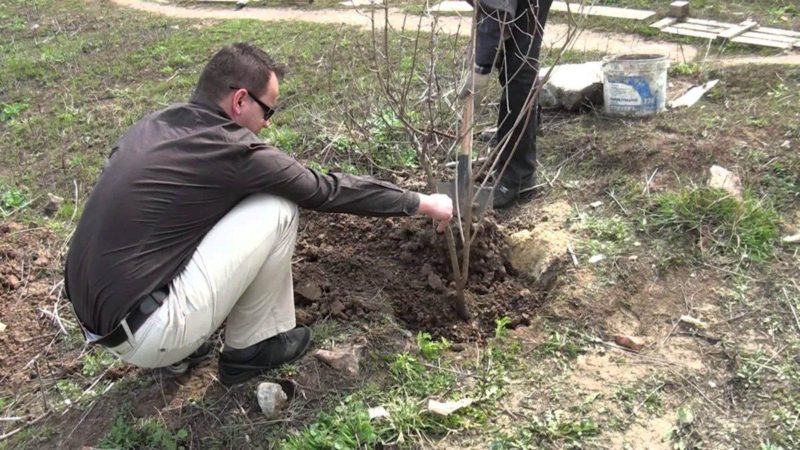
In order for the plant to take root, follow the recommendations:
- planting is carried out during leaf fall until the first frost - usually in September or at the very beginning of October;
- the air temperature should be above +4°C, and the soil should not be frozen;
- for wintering seedlings, covering material is used: sawdust, roofing felt, peat;
- although viburnum is not afraid of frost, preference is given to areas protected from the wind;
- If, according to preliminary forecasts, a severe winter is expected, spring planting is preferable.
Advantages and disadvantages of autumn planting
By planting and growing shrubs in the fall, gardeners receive the following benefits:
- over the summer the soil warms up well and is more favorable for root formation than in the spring;
- the soil around the plant, under the influence of autumn rains and snowfall, will settle, compact and protect the plant from the cold;
- in late autumn and winter, moisture-loving viburnum does not need frequent watering;
- Wintering provides the necessary rest for the seedling, but in the spring the plant will begin to actively sprout.
With all the advantages, this landing option also has disadvantages:
- in case of severe frosts, the seedling may die;
- Plants left unattended may be favored by rodents.
Preparation of planting material
It is advisable to purchase seedlings with a closed root system - in pots or grown in the ground. This ensures better survival rate and high-quality rooting. Closed roots do not dry out, and the vegetative parts of such a plant do not need pruning.
The recommended height of the cuttings is from 20 cm. The leaves and branches of the seedling must be elastic.
Before planting, the viburnum is carefully inspected; dried branches and dead roots are removed using pruning shears. The pot with the plant is soaked in water for 30-60 minutes, seedlings with bare roots are kept in a solution of the drug to improve root formation.
Ground
Kalina prefers:
- neutral or slightly acidic (pH from 5.5 to 6.5) soil;
- well-moistened soil, but without stagnant water, so chooses areas with deep groundwater (no closer than 1 m to the surface).
Sandy, peat and podzolic soil is not suitable for growing viburnum. A bush on such soil most likely will not bear fruit. The plant also needs a well-lit area, but partial shade is better.
Immediately before planting the seedling, the area is dug up and weeded. It is better to avoid applying herbicides - they suppress the growth of not only weeds, but also seedlings.
Mineral or organic fertilizers are added to poor soil a month before planting. So, for a planting hole measuring 60x60x50 cm, you need:
- 1 bucket of humus or peat;
- 0.5 tbsp. potassium sulfate;
- 1 tbsp. superphosphate;
- 1 tbsp. dolomite flour;
- 2 tbsp. urea.
This “cocktail” is mixed with soil, poured 2/3 into the hole, and 30-40 liters of water are poured on top.
Reference. Another option for a nutrient mixture for planting viburnum: 3 kg of rotted manure, 250 g of ash and 10 g of “Nitroammofoska” per 1 m² of soil.
Instructions for planting viburnum
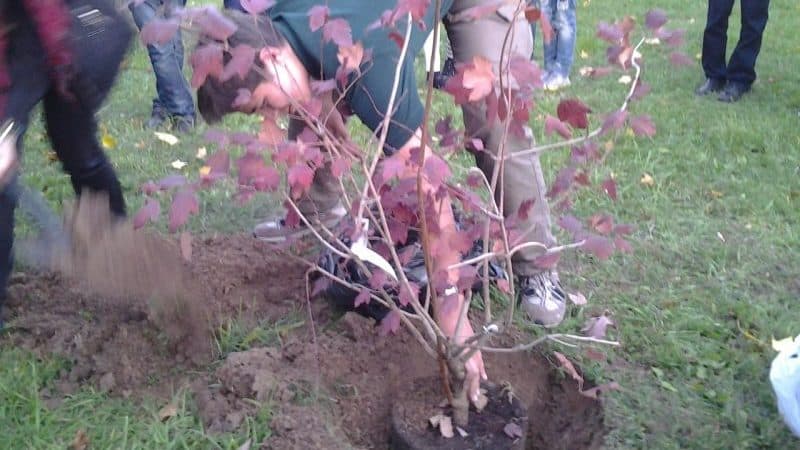
Work progress:
- Planting holes are dug at a distance of at least 1.5 m from each other.
- Make holes 50 cm deep and 60 cm wide.
- The bottom of the pit is lined with drainage material - crushed stone, broken brick, etc.
- It is possible to additionally add 20-25 g of “Nitroammophoska”.
- The seedling is placed vertically in the hole, sprinkled with soil and compacted thoroughly. It is optimal to deepen the root collar by 5-7 cm.
- Mulch is laid around the trunk - sawdust, peat, mown grass or dry leaves. The mulch is not placed close to the trunk - this way it will not cause the seedling to rot during prolonged autumn rains.
Further care
Regular care of viburnum includes the following activities.
Weekly watering
Its abundance depends on the age of the bush and the weather conditions of the season. General rule: the soil should be moistened to a depth of 40 cm.
Water the viburnum in the evening, avoiding long breaks between procedures.
Top dressing
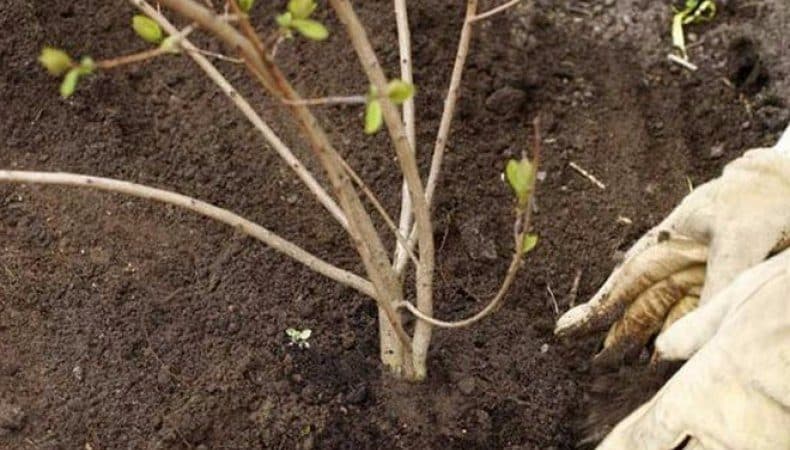
Use dry fertilizers:
- First carried out on spring buds or during the opening of leaves. Under each bush add 1.5-2 tbsp. l. urea, evenly distributed over the surface, then watered abundantly.
- Second - before the viburnum blooms. Must contain potassium. For example, 2 tbsp. l. potassium sulfate or 500 ml of wood ash.
- Third - after the plant has flowered. During this period, complex mineral fertilizers performed well - “Nitroammofoska”, “Nitrofoska”. Norm - 2 tbsp. l. on the bush.
- Fourth - when preparing viburnum for wintering. A solution of superphosphate and potassium sulfate (2 tablespoons per 10 liters of water) is suitable, and as an alternative, mulching the tree trunk circle with a layer of manure or compost.
Other events
Kalina also needs:
- Periodic loosening soil and weeding.
- Mulching. It protects the root system from temperature changes and prevents the appearance of weeds. For mulch, use tree bark, wood chips or peat.
- Preventive spraying fungicides against various diseases and insecticides against pests. Viburnum most often suffers from powdery mildew, ascochyta blight, gray rot and fruit rot. Among the worst pests are the viburnum leaf beetle, the black leaf roller aphid, the viburnum leaf roller, the viburnum and honeysuckle gall midges, and the green lobed moth.
- Trimming. Rejuvenating and shaping are carried out in early spring before the movement of juices begins. Sanitary - in the fall after shedding the crown, but before the onset of frost.
With proper care of the plantings, the shrub will begin to bear fruit in 3-5 years.
Reproduction and planting of viburnum in autumn
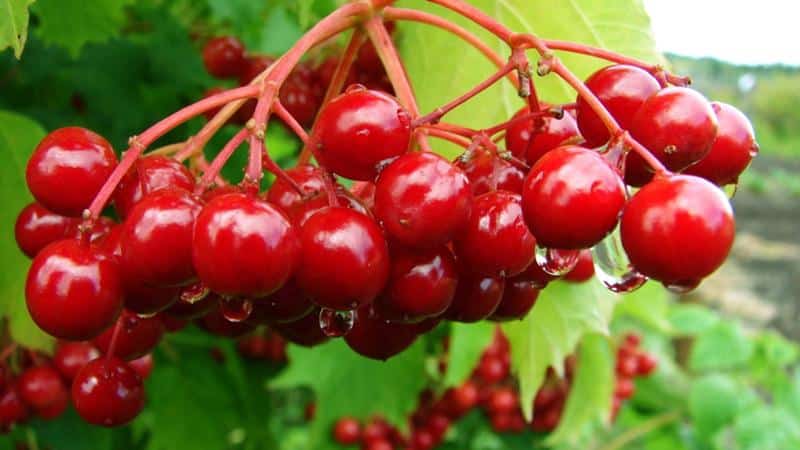
Seed and vegetative propagation of viburnum is possible. However, growing a bush from seeds is a long, labor-intensive and often fruitless process. Therefore, they are most often propagated vegetatively: division, cuttings, vertical and horizontal layering.
By division
They divide mainly specimens of valuable, generously fruiting varieties of viburnum. To do this, the plant must have a well-developed root with buds.
The dug up bush is carefully examined, deciding how many parts it can be divided into. Each of them must have an adult shoot with several roots. Then, with a sharp tool (knife, shovel, ax), the root system is carefully cut, and the cut areas are treated with charcoal.
Each part is planted in a separate, pre-fertilized planting hole.
Cuttings
Cuttings are harvested during the flowering period of viburnum (June - early July). A sign that a bush is ready to divide is the elasticity of its shoots: if you bend a branch, it will not break.
Procedure:
- The middle part of the shoot, 10-12 cm long, is cut obliquely. 2-3 nodes should remain on the cutting. The lower leaves are torn off, and the upper ones are shortened by half.
- The lower cut of the cutting is kept in a root formation and growth stimulator (Kornevin, Heteroauxin, etc.) in accordance with the instructions for the drug.
- Prepare a soil mixture of peat and river sand in a 1:1 ratio.
- The cuttings are planted in the prepared soil at an angle, carefully deepening them. Keep a distance of at least 5 cm between plantings.
- The planted cuttings are covered with a transparent dome - a large glass jar, cut into a plastic bottle or plastic film. The optimal humidity in an improvised “greenhouse” is 70-90%, so the plants are sprayed with clean warm water several times a day.
- After 3 weeks, the cuttings will give roots. The plants begin to harden - the dome is removed for several hours every day. Gradually, the time in the open air is increased, after which the shelter is completely removed.
- For the winter, the cuttings are removed indoors.
- In the spring, daily hardening is repeated for 2 weeks.
- Shoots are planted in open soil for growing according to a 50x15 cm pattern.
- The cuttings are planted in a permanent place when they are completely strong and grow.
By layering
The easiest and most effective way to propagate viburnum is to use vertical layering.
The procedure is carried out as follows:
- After the beginning of leaf fall in young specimens, the lower branches with 2-4 buds are shortened, and the stem of the layer is spud high.
- In the spring, shoots sprout from the buds that are underground. When they grow 8-10 cm, re-hilling is carried out to a height of 4-5 cm.
- When the shoots reach 20-30 cm, a hole is dug around them to be tied at the base with copper wire. Then the shoots are again spudded to 1/3 of their height.
- After 2 weeks, hilling is repeated.
- Next fall, the cuttings are dug up, cut off from the parent bush and planted in a permanent place.
Propagation by horizontal layering is possible:
- A two- or three-year-old branch is pruned so that 2-4 buds remain on it.
- A year later, a new shoot should grow in this place. It is again shortened by 1/5, bent to the ground and placed in a previously prepared groove 5-6 cm deep. The shoot is fixed with hooks.
- When the shoots grown from its buds reach 10-15 cm in height, the furrow is filled with a mixture of peat and humus and the cuttings are buried. The tops of the branches should remain on the surface.
- During the summer season, 2-3 hillings are performed.
- In the fall, the buried shoot is cut off from the mother bush, the cuttings that have given roots are separated from each other and planted in a permanent place.
Features of autumn planting depending on the region
Under natural conditions, viburnum grows in the European part of Russia, Siberia, Central Asia, and the Caucasus.In more northern regions with long winters and frozen, poor soil, the plant does not take root well.
Autumn planting in different regions is carried out taking into account weather conditions - the seedling must be in the soil at least 10 days before the first frost:
- Central Black Earth region, Far East - mid-end of September;
- Middle zone - early September;
- Ural and Siberia - late August - early September.
Depending on the type of viburnum
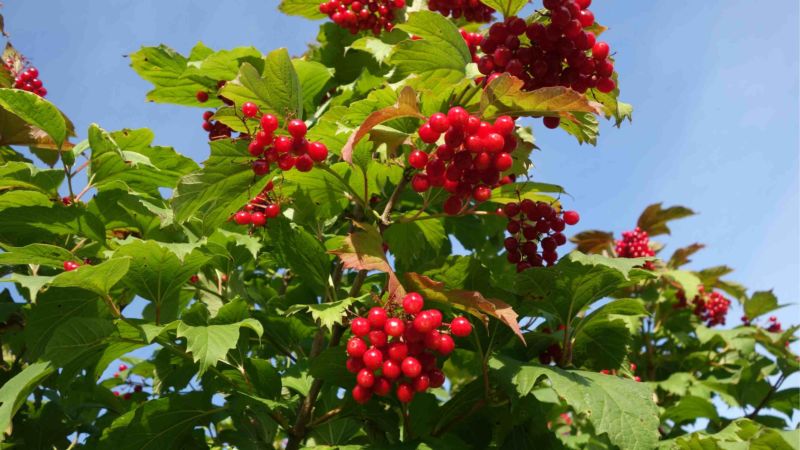
When choosing varieties for autumn planting, they are guided by their ability to tolerate cold temperatures. Almost all varieties of viburnum, including decorative ones, tolerate frosts down to -10...-15°C. However, if in a particular region there are severe frosts in winter, it is better to opt for the following types:
- Kalina red (ordinary). The traditional variety of shrub is named after the scarlet color of its drupe fruit. The varieties Shukshinskaya, Zarnitsa, Sunset, Maria, Ryabinushka, Vigorovskaya tolerate harsh winters well.
- Kalina wrinkled - an evergreen shrub with yellow-orange flowers and small black fruits. It is highly resistant to frost and drought.
- Kalina pride It has hairy leaves and trunks, creamy white flowers and black berries. The Aureum variety is frost-resistant.
This is interesting:
How to properly plant raspberries in the fall and further care for them.
Proven methods for storing grape cuttings in winter and checking them before planting.
Advice from experienced gardeners
Gardeners with extensive experience in growing viburnum have made interesting observations:
- on a bush growing in a shaded area, pests settle much less frequently;
- for viburnum it is important that water does not stagnate in the soil;
- to improve pollination, it is better to plant several viburnum bushes every 3-4 m;
- Planting viburnum in mountainous areas helps strengthen the soil.
Conclusion
Viburnum will become a real decoration of the garden plot. Autumn planting using one of the vegetative methods - division, cuttings or layering - gives good survival of the shrub and its fruiting approximately 3-5 years after the appearance of shoots in the seedling.
I am going to plant a viburnum sapling on my plot this year. Your advice will come in handy. Thank you.